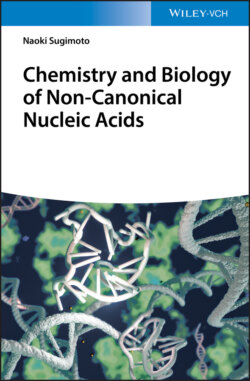Читать книгу Chemistry and Biology of Non-canonical Nucleic Acids - Naoki Sugimoto - Страница 20
2.2 Unusual Base Pairs in a Duplex
ОглавлениеAs in Chapter 1, the canonical structure of nucleic acids is double-stranded helix with Watson–Crick base pairs (Figure 2.1), which are almost identical in their geometric and dimensional arrangement in the helix. The sugar groups are both attached to the bases on the same side of the base pair. The distance between C1′ atoms of the sugars on opposite strands is essentially the same. These geometric features enable any sequence of Watson–Crick base pairs fit into the duplex. On the other hand, a large number of other arrangements and hydrogen bonding patterns of base pairs are possible, and many have been observed experimentally such as using X-ray and NMR analyses. X-ray analysis can define the duplex structures, which incorporate the non-Watson–Crick base pairs and provide details of their hydrogen bonding scheme [1]. On the other hand, NMR analysis provides information regarding the dynamics of the nucleic acid conformation such as mismatched base pairs, in which transient tautomeric and anionic species form Watson–Crick-type hydrogen bonds [2].
Figure 2.1 Watson–Crick and Hoogsteen base pairs in double helix. Chemical structures of A-T (a) and G-C (b) Watson–Crick base pairs. Chemical structures of A-T (c) and G-C+ (d) Hoogsteen base pairs. N3 atom of cytosine nucleobase is protonated. (e) Structure of DNA duplex consisting of all A-T Hoogsteen base pairs (PDBID: 1RSB). (f) Structure of DNA duplex containing two consecutive G-C+ Hoogsteen base pairs (PDB ID: 1QN3). The DNA duplex is bending due to interaction of TATA-box binding protein. Nucleobases forming the Hoogsteen base pairs are emphasized dark. In (e) and (f), hydrogen bonds between the Hoogsteen base pairs are shown in dashed lines.
